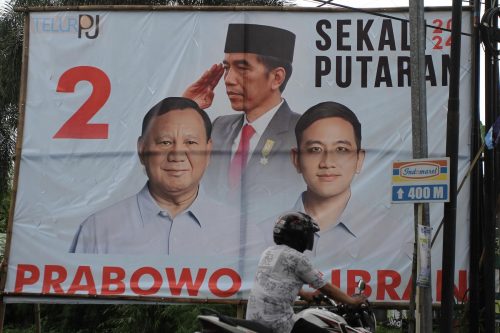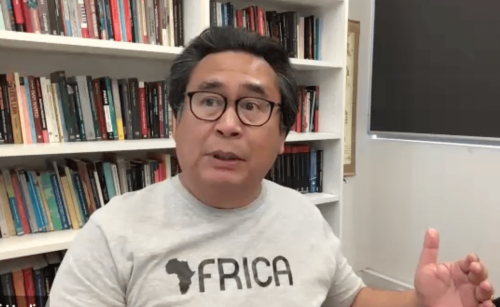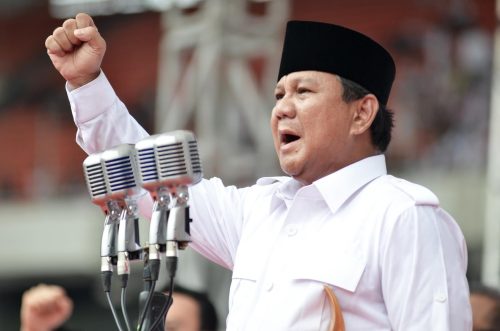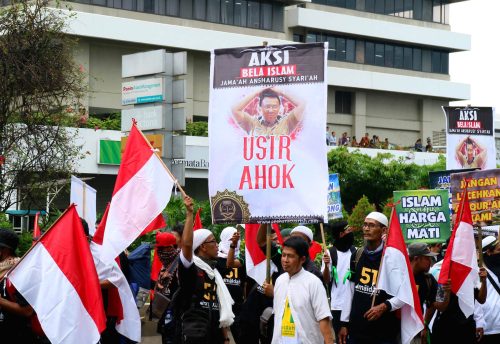Indonesia

In 2014, Indonesia elected the “common man” leader, Widodo Jokowi. A humble and cool-headed populist leader, he campaigned on technocratic solutions to wealth inequality and elite corruption. More conventional populists had failed to solve the country’s problems. In his two terms in office, Jokowi has fulfilled a number of his populist promises but has grown increasingly intolerant towards the political opposition. Under his rule, Indonesia has fallen behind on democratic freedoms and human rights, while Jokowi has seemly defeated the more traditional Islamist and anti-elite populists.
Indonesia is located in Southeast Asia and Oceania. It is the largest island country in the world. Java is the largest and most populous of its many landmasses. The earliest traces of pre-human settlements date as far back as two million to 500,000 years ago. Over the centuries, the islanders have been influenced by Hinduism, Buddhism, Islam, and Christianity, giving the nation a diverse culture, despite presently being a Muslim-majority country. The first Europeans to arrive in the region were the Portuguese, led by Francisco Serrão, in 1512. They were followed by the British and the Dutch. In the 17th century, the Dutch East India Company (VOC) established a stronghold; the formal colonization of the “Dutch East Indies” followed in 1800. The colony provided quinine, pepper, rubber, coconut products, tea, sugar, coffee, and oil to the Dutch.
Independence movements remained alive and vibrant in the islands but were heavily quashed by the colonial forces. It was the Japanese invasion and conquest of the region during WWII that led the Dutch to retreat. Janani Sukarno and his group of nationalist leaders supported the Japanese with the hope of gaining freedom at the end of the war. After the surrender of the Japanese Army, Sukarno-led nationalists declared independence on August 17, 1945. However, it took the Indonesians another two years of armed resistance and diplomatic efforts to finally curb all efforts by the Dutch to recolonize the islands.
The country’s main ideology is Pancasila, or the Five Principles: nationalism, internationalism, democracy, social prosperity, and belief in God. However, for several decades the country was never a democracy. After a turbulent political beginning, the country was governed by a “Guided Democracy,” which was an autocratic rule justified by the supposed-need for political stability (Leslie, 1957). During the 1960s, the regime supported the Communist Party of Indonesia (PKI); however, this move alienated two powerful stakeholders – the military and Islamic factions. By 1965, hyper-inflation combined with the conflict between the military and PKI led many Indonesians to have a change of heart. In 1967, with populist support, the armed forces and Islamist political groups forced Sukarno to resign.
The appointment of Suharto as the country’s second president did little to change the political structure. His rule also devolved into a dictatorship. Under his “New Order,” a centralized, military-led government remained in power until Suharto’s forced resignation in 1998 (Sub, 2016). Under Suharto, there was a renewal of identification with conservative Islamic views. There were calls for the institutionalization of “political Islam.” This was tied to the emergence of a Muslim middle-class that had begun to take shape pre-independence but had remained secondary to the successful, quasi-secular business-class of the predominately ethnic-Chinese citizenry, cultivating a sentiment of economic marginalization (Sidel 2008).
For almost three decades, economic progress supported Suharto’s regime; but while the Gross Domestic Product (GDP) grew, income disparities remained high. Understanding the importance of the Islamic factions, Suharto did not oppose them. It was the 1997 Asian financial crisis that prompted a wave of dissatisfaction that finally threw him from power. The dictator’s corruption combined with massive ethnic rioting specifically targeting Chinese Indonesians led to mass unrest in the county. Police brutality turned peaceful protests into riots, which paralyzed Jakarta. Thousands of university students demanded Suharto’s resignation, and all attempts delay his resignation was rejected by the masses (Sub, 2016).
The fall of the New Order, precipitated by both populist and oligarchic support, ushered Indonesia into a democratic era. Over roughly a decade, the country’s path to democracy was praised by the West as a model for Muslim countries and post-dictatorship (Muhtadi & Muslim, 2020). Despite some causes for optimism, maintaining democracy is still a challenge for the country.
The influence of two successive dictatorships cannot be divorced from the contemporary socio-political dynamics of the country. Firstly, the fall of Suharto led to greater political freedoms, which had been curtailed for decades. This created an opportunity for the emergence of Islamic political parties but also more liberal groups. Thus, the political spectrum has become somewhat divided between conservative religious groups and the liberal democratic groups (Zarkasyi, 2008). Secondly, there has not been a consolidation of democratic forces post-Suharto. Instead, years of income inequality meant a handful of elites have entered the political arena, ushering in an era of oligarchs (Fukuoka, 2013). While Indonesia has seen improvements among many economic indicators, it still remains a developing country with major issues related to human development, unequal distribution of wealth, and growing threats from climate change.
The 2014 Presidential elections brought to light two faces of populism in the country. The traditional populist, Prabowo Subianto, of the Great Indonesia Movement Party (GIMP), competed against Joko Widodo – more popular Jokowi of the Indonesian Democratic Party of Struggle (IDPS) (Mietzner, 2015). Subianto, a former Army general and one-time son-in-law of Suharto left his Golkar Party to form GIMP, a right-wing populist party. He found his voter bloc in mostly rural and working-class communities, and he promised to revamp the “corrupt” government and use his military-style efficiency to address the country’s problems. While Subianto claimed to protect minority rights, GIMP took a clear homophobic stance, which garnered support in the largely Muslim country. GIMP hoped to gain support from the poor and uneducated segments of society by opposing the rich and powerful who were “looting” the country. This campaign placed Subianto firmly amongst classic developing-world populists – a member of the elite who still “connects” with the masses and promises to fix the country and who gains support through the cult of his personality (Mietzner, 2015).
Opposed to Subianto, Jokowi was a self-made man who campaigned on a milder and more pragmatic brand of populism. A poor farmer’s son, he rose to prominence, becoming the mayor of his hometown of Surakarta and later Governor of Jakarta. Rather than presenting himself as neo-authoritarian, his humble beginnings and grassroots linkages with the people provided Jokowi authentic credentials to challenge the arrogant and hostile political status quo (Mietzner, 2015). Moreover, rather than promising the voters a “grand clean up” or revamping of the current political system, his campaign focused on a promise to provide people with improved services. Rather than targeting any groups, either the country’s elite or foreign powers, as the “enemy,” Jokowi introduced technocratic populism, promising a better life for the people through improved public service delivery. His previous success at improving health and education for his constituents earned him credibility in the eyes of the voters (Mietzner, 2015).
In 2014, Jokowi secured his first term by winning 53 percent of the popular vote, while his party was able to win control of the People’s Representative Council of the Republic of Indonesia (DRP) through a coalition. Subianto and his party found themselves as the opposition, with 47 percent of the vote going in their favor. Jokowi’s technocratic solutions clearly appealed to the Indonesian people, especially compared to the traditional political right’s populism. Nevertheless, 47 percent of votes for Subianto demonstrate that Indonesia remains a fertile ground of traditional populist ideals.
During his first term, Jokowi faced many challenges, but his non-confrontational style aided him in dealing with the oligarchy and military. A rise in Islamic sentiments put him in a precarious position. The Defending Islam Movement (DIM) emerged as a result of the “blasphemous” words uttered by Jakarta’s Governor, a Christian of Chinese descent. Over one million Muslims participated in rallies across the country between 2016-17. Moreover, Jokowi’s hard stance against radical Islamic groups and anti-terrorism activities earned him the ire of many moderate religious organizations, such as the Islamic Defenders Front (FPI) and Islamic Community Forum (FUI).
On the other hand, Jokowi’s increased public spending has helped him achieve some of his campaign promises, albeit while blowing up the country’s external debts to as high as 8.3 percent (Indfinancials, 2020). Jokowi was still able to secure his second term in the 2019 elections when he increased his vote share to 55%. His choice of Ma’ruf Amin, a cleric from the Muslim organization Nahdlatul Ulama (NU), as Vice President shows populist religious forces are a part of mainstream politics (Chew, 2019). NU was established nearly a century ago as a traditionalist Sunni Islam Shafi’i school of jurisprudence. The organization and its followers are moderates, making it the largest Muslim organization in the country. Subianto again remained the leading opposition force, winning 45% of all votes in 2019. Subianto again drew his support from the radical and hardline Muslim factions around Java (Arifianto, 2019).
The opposition has portrayed Jokowi as a politician who lacks “strong Islamic credentials” and aims to implement policies that run counter to the beliefs and values of the conservative religious Muslim groups throughout Indonesia (Arifianto, 2019). However, the nexus of populism and religion is an emerging theme in Indonesian politics, potentially posing a threat to democracy.
Under Jokowi, basic human rights have declined: his anti-terrorism measures provide governing bodies with leeway to grossly violate human rights. His government has chosen political stability over open dissent, curbing freedom of expression. Several newspapers have been shut down, and many individuals have been charged for opposing his policy choices (Bland, 2019).
It is unclear if technocratic populism will remain a force in the coming years or if the more traditional brand of populism will return to power. It is however clear that religion is becoming a central focus of politics, and economic conditions are likely to remain precarious in a post-COVID-19 world, widening already extant social fissures. These factors are bound to influence Indonesia’s democratic future under Jokowi’s lite-populism.
By Ihsan Yilmaz
October 21, 2020.
References
— (2020). “Indonesia external debt grows 8.3% in November.” IDN Financial. January 15, 2020. https://www.idnfinancials.com/news/31301/indonesia-external-debt-grows-november (accessed on October 1, 2020).
Arifianto, R. Alexander. (2019). “Is Islam an increasingly polarizing political cleavage in Indonesia?” Brookings. April 25, 2019. https://www.brookings.edu/blog/order-from-chaos/2019/04/25/is-islam-an-increasingly-polarizing-political-cleavage-in-indonesia/ (accessed on October 1, 2020).
Bland, Ben. (2019). “How President Joko Widodo Is Eroding Indonesia’s Democracy.” Italian Institute for Insertional Political Studies. December 11, 2019. https://www.ispionline.it/en/pubblicazione/how-president-joko-widodo-eroding-indonesias-democracy-24587 (accessed on October 1, 2020).
Chew, Amy. (2019). “Indonesia’s largest Muslim group set for bigger role in Jokowi’s second term.” This Week in Asia. August 2, 2019. DOI: 10.1111/j.1478-9302.2012.00286.x
Fukuoka, Yuki. (2013). “Oligarchy and Democracy in Post-Suharto Indonesia.” Political Studies Review. 11:52-64. https://www.researchgate.net/publication/275075301_Oligarchy_and_Democracy_in_Post-Suharto_Indonesia (accessed on October 1, 2020).
Leslie H. Palmier. (1957). “Sukarno, the Nationalist.” Pacific Affairs, 30(2), 101-119. doi:10.2307/2752683 (accessed on October 1, 2020).
Muhtadi, Burhanuddin and Muslim, Kennedy. (2020). “Populism, Islamism, and Democratic Decline in Indonesia.” The Middle East Institute. August 4, 2020. https://www.mei.edu/publications/populism-islamism-and-democratic-decline-indonesia (accessed on October 1, 2020).
Sidel, John. (2008). “The Social Origins of Democracy Revisited: Colonial State and Chinese Immigrant in The Making of Modern Southeast Asia.” Comparative Politics.
Sub, J. (2016). “The Suharto Case.” Asian Journal of Social Science. 44(1/2), 214-245. http://www.jstor.org/stable/43953988 (accessed on October 1, 2020).
Leslie H. Palmier. (1957). “Sukarno, the Nationalist.” Pacific Affairs. 30(2), 101-119. doi:10.2307/2752683 (accessed on October 1, 2020).
Mietzner, Marcus. (2015). Reinventing Asian Populism: Jokowi’s Rise, Democracy, and Political Contestation in Indonesia. Honolulu: East-West Center.
Zarkasyi, F. Hamid. (2008). “The rise of Islamic religious-political movements in Indonesia: The background, present situation and future.” Journal of Indonesian Islam. 2(2):336. DOI: 10.15642/JIIS.2008.2.2.336-378 (accessed on October 1, 2020).











